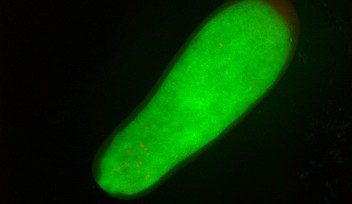図2
図2 細胞膜を、ほぼ細胞全体にわたって撮影した画像(左端)。接着斑の部分を、順次拡大している(中、右)。上段は、通常分解能の画像。下段は点描法による超解像PALM画像。見ている分子は、接着斑を構成するパキシリン。下段の右端は、すぐ左の画像を定量解析したもの。緑が島の輪郭。赤が接着斑全体の輪郭。
Date:
26 May 2023
Copyright OIST (Okinawa Institute of Science and Technology Graduate University, 沖縄科学技術大学院大学). Creative Commons Attribution 4.0 International License (CC BY 4.0).














